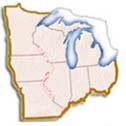Connect With Us
|
Indiana BatDraft Recovery Plan: First Revision
Below is the Executive Summary of the Draft Recovery Plan. Follow this link for the complete Indiana Bat Draft Recovery Plan; first Revision (260 pages; 1.37MB; PDF)
Executive SummaryCurrent Species Status:The Indiana bat is a temperate, insectivorous, migratory bat that hibernates colonially in caves and mines in the winter. In spring, reproductive females migrate and form maternity colonies where they bear and raise their young in wooded areas. Males and nonreproductive females typically do not roost in colonies and may stay close to their hibernaculum or migrate to summer habitat. Summer roosts are typically behind exfoliating bark of large, often dead, trees. Both males and females return to hibernacula in late summer or early fall to mate and enter hibernation.
The species was originally listed as in danger of extinction under the Endangered Species Preservation Act of 1966, and is currently listed as endangered under the Endangered Species Act of 1973, as amended. The current Recovery Priority of the Indiana Bat is 8, which means that the species has a moderate degree of threat and high recovery potential. As of October 2006, the Service had records of extant winter populations at approximately 281 hibernacula in 19 states and 269 maternity colonies in 16 states. The 2005 winter census estimate of the population was 457,000.
Biologically intrinsic needs of this species include limiting use of fat during hibernation, obligate colonial roosting, high energy demands of pregnant and nursing females, and timely parturition and rapid development and weaning of young. Factors that may exacerbate the bats vulnerability because of these constraints include energetic impacts of significant disruptions to roosting areas (both in hibernacula and maternity colonies), availability of hibernation habitat, and connectivity and conservation of roosting-foraging and migration corridors. Habitat Requirements and Limiting Factors:During winter, Indiana bats are restricted to suitable underground hibernacula. The vast majority of these sites are caves located in karst areas of the east-central United States; however, Indiana bats also hibernate in other cave-like locations, including abandoned mines. Suitable hibernacula in the central and southern United States often provide a wide range of vertical structure. These hibernacula tend to have large volumes and often have large rooms and vertical or extensive passages, often below the lowest entrance. Cave volume and complexity help buffer the cave environment against rapid and extreme changes in outside temperature, and vertical relief helps provide a range of temperatures and roost sites. Most Indiana bats hibernate in caves or mines where the ambient temperature remains below 10°C (50.0°F) but infrequently drops below freezing, and the temperature is relatively stable.
In summer, most reproductive females occupy roost sites under the exfoliating bark of dead trees that retain large, thick slabs of peeling bark. Primary roosts usually receive direct sunlight for more than half the day. Roost trees are typically within canopy gaps in a forest, in a fenceline, or along a wooded edge. Habitats in which maternity roosts occur include riparian zones, bottomland and floodplain habitats, wooded wetlands, and upland communities. Indiana bats typically forage in semi-open to closed (open understory) forested habitats, forest edges, and riparian areas.
Threats to the Indiana bat vary during its annual cycle. At the hibernacula, threats include modifications to caves, mines, and surrounding areas that change airflow and alter microclimate in the hibernacula. Human disturbance and vandalism pose significant threats during hibernation through direct mortality and by inducing arousal and consequent depletion of fat reserves.
Natural catastrophes can also have a significant effect during winter because of the concentration of individuals in a relatively few sites. During summer months, possible threats relate to the loss and degradation of forested habitat. Migration pathways and swarming sites may also be affected by habitat loss and degradation. In addition to these threats, significant information gaps remain regarding the species’ ecology that hinder sound decision-making on how best to manage and protect the species. Recovery Strategy:Given the population trends, biological constraints, habitat requirements, threats, and information needs, the recovery program for has four broad components:
Like its predecessor, this recovery plan continues to have a focus on protection of hibernacula but also increases the focus on summer habitat and proposes use of four Recovery Units: Ozark-Central, Midwest, Appalachian Mountains, and Northeast. Delineation of these Recovery Units relied on a combination of preliminary evidence of population discreteness and genetic differentiation, differences in population trends, and broad-level differences in macrohabitats and land use. Recovery Units serve to protect both core and peripheral populations and ensure that the principles of representation, redundancy, and resiliency are incorporated. Recovery Goals:The ultimate goal of this Recovery Plan is to remove the species from the Federal list of Endangered and Threatened Wildlife. The intermediate goal is reclassification of Indiana bat to threatened status. Recovery Objectives:To reclassify the Indiana bat to threatened, the following objectives must be achieved:
The Indiana bat will be considered for delisting when the Reclassification Criteria have been met, and the following additional criteria have been achieved:
If research on summer habitat requirements indicates the quality and quantity of maternity habitat is threatening recovery of the species, the Service will amend these objectives and the following criteria. Recovery Criteria:Reclassification:
Delisting:
Actions Needed:
Date of Recovery:Contingent on funding and implementation of recovery actions, full recovery may occur by 2027.
Follow this link for the complete Indiana Bat Draft Recovery Plan; first Revision (260 pages; 1.37MB; PDF)
|
||||||||||||
Last updated:
July 19, 2016
|
|||||||||||||




